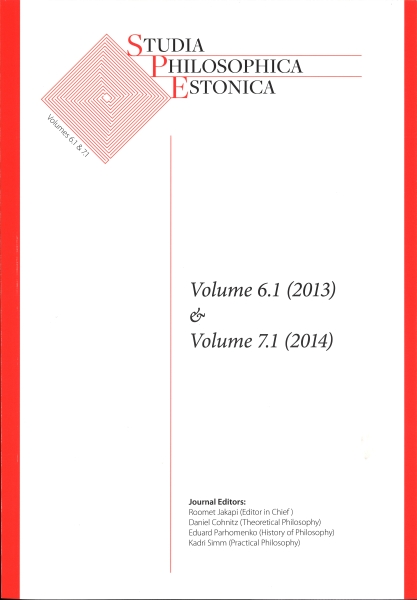Wittgensteinian Perspectives on the Turing Test
DOI:
https://doi.org/10.12697/spe.2014.7.1.02Keywords:
Turing test, artificial intelligence, AI, thinking, WittgensteinAbstract
This paper discusses some difficulties in understanding the Turing test. It emphasizes the importance of distinguishing between conceptual and empirical perspectives and highlights the former as introducing more serious problems for the TT. Some objections against the Turingian framework stemming from the later Wittgenstein’s philosophy are exposed. The following serious problems are examined: 1) It considers a unique and exclusive criterion for thinking which amounts to their identification; 2) it misidentifies the relationship of speaking to thinking as that of a criterion; 3) it neglects the “natural” course of the development in semantics. However, these considerations suggest only that it is problematic to label a successful chatbot as a “thinking entity” without further qualifications, but not necessarily and once and for all incorrect. Philosophy has only little to say about the technical possibility of creating such an effective program.
Downloads
References
Block, N. (1978). Troubles with functionalism, in C.W. Savage (ed.), Minnesota studies in philosophy of science, IX, Minnesota Press, Minneapolis, pp. 260-325.
Block, N. (1981). Psychologism and Behaviorism, Philosophical Review, 90: 5-43.
Brembs, B. (2011). Towards a scientific concept of free will as a biological trait: spontaneous actions and decision-making in invertebrates, Proceedings of the Royal Society B, 278: 930-939.
Chomsky, N. (1980). Rules and Representations, Columbia Press, New York.
Chomsky, N. (2008). Turing on the “Imitation Game”, in R. Epstein, G. Roberts and G. Beber (eds.), Parsing the Turing Test. Philosophical and Methodological Issues in the Quest for the Thinking Computer, Springer Science + Business Media B.V., Dordrecht, pp. 103-106.
Dennett, D. (1996). Kinds of Minds. Towards an Understanding of Consciousness, Basic Books: The Science Masters Series, New York.
Halpern, M. (2006). The Trouble with the Turing Test, The New Atlantis, 11: 42-63.
Harnad, S. (1991). Other bodies, other minds: A machine incarnation of an old philosophical problem, Mind and Machines, 1: 43-54.
Lem, S. (1996). Tajemnica chińskieho pokoju, TAiWPN Universitas, Krakow
Liebowitz, J. (1989). If there is artificial intelligence, is there such a thing as artificial stupidity?, ACM SIGART Bulletin, 109: 26-28.
Lyon, A. (1974). Criteria and Evidence, Mind, 83: 211-227.
Marconi, D. (1997). Lexical Competence, MIT Press, Cambridge (MA).
Millar, P. H. (1973). On the Point of the Imitation Game, Mind, 82: 595-597.
Moor, J. H. (2001). The status and future of the Turing test, Mind and Machines, 11: 73-93.
Mori, M. (1970). The Uncanny Valley, Energy, 7(4): 33-35. Transl. K. F. MacDorman and T. Minato. (2005). Retrieved from http://www.androidscience.com/theuncannyvalley/proceedings2005/uncannyvalley.html
Penco, C. (2012). Updating the Turing Test. Wittgenstein, Turing and Symbol Manipulation, Open Journal of Philosophy, 2: 189-194.
Proudfoot, D. (2005). A New Interpretation of the Turing Test. The Rutherford Journal: The New Zealand Journal for the History and Philosophy of Science and Technology, Article 010113. Retrieved from http://rutherfordjournal.org/article010113.html
Rohde, M. (2009). Enaction, Embodiment, Evolutionary Robotics. Simulation Models for a Post-Cognitivist Science of Mind, Atlantis Press, Amsterdam & Paris.
Rorty, R. (1989). Contingency, Irony and Solidarity, Cambridge University Press, Cambridge.
Saygin, A. P., Cicekli, I., and Akman, V. (2000). Turing test: 50 years later, Mind and Machines, 10: 463-518.
Schweizer, P. (1998). The truly total Turing test, Mind and Machines, 8: 263-272.
Searle, J. (1980). Minds, Brains and Programs, Behavioral and Brain Sciences, 3: 417-457.
Shanker, S. (1998). Wittgenstein’s Remarks on the Foundations of AI, Routledge, London.
Turing, A. (1936). On computable numbers, with an application to the Entscheidungsproblem, Proceedings of the London Mathematical Society, 42: 230-265.
Turing, A. (1950). Computing machinery and intelligence, Mind, 59: 433-460.
Weizenbaum, J. (1966). ELIZA-A Computer Program for the Study of Natural Language Communication Between Men and Machines, Communications of the ACM, 9: 36-45.
Whitby, B. (1996). The Turing Test: AI's Biggest Blind Alley?, in P. Millican and A. Clark (eds.), Machines and Thought: The Legacy of Alan Turing, Oxford University Press, Oxford, pp. 53-62.
Winch, P. (1980-1981). “Eine Einstellung zur Seele”, Proceedings of the Aristotelian Society, 81: 1-15.
Wittgenstein, L. (2009). Philosophische Untersuchungen/Philosophical Investigations. Revised 4th edition, Wiley-Blackwell, Oxford.
Wittgenstein, L. (1961). Tractatus logico-philosophicus, Routledge & Kegan Paul, London.
Zlotowski, J., Proudfoot, D., and Bartneck, C. (2013). More Human Than Human: Does The Uncanny Curve Really Matter?, Proceedings of the HRI2013 Workshop on Design of Humanlikeness in HRI from uncanny valley to minimal design, Tokyo, pp. 7-13.

